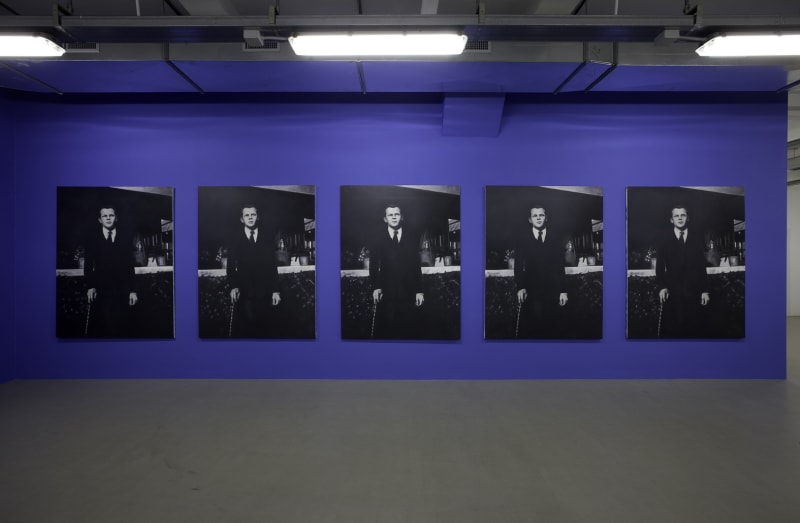There is in all of Di Matteoʼs work an ironic and auto-ironic temperament that borderlines on the paradox, and through which the artist investigates the potential meaning of painting. Frequently, the work is presented as a series of images, made of three or five exemplars, that are all entirely the same, and maniacally, we must insist on such a term, copied in paint, departing from found reproductions.
The images are chosen for their significance, which is particularly striking in the sequence of five large identical portraits of Arafat, which soon recalls the geopolitical drama of which the personage is both protagonist and witness. The close-up of the portrait, which cuts out some details, the black and white of the photograph, everything is transposed into paint out of a scrap of newspaper from which the work is initiated. All comes to be magnified and repeated as though from the omnipotent delirium of the portraitist, while in reality, this results in the opposite of every will to power: the artist, in the slavish repetition of every stroke, in the end annuls the significant force of the image and transforms it under the pretext of a paradoxical test. That which Di Matteo expresses, or stages, is an aspect of painting in which labour, fatigue, technique, among others, posits (on a more truly conceptual level) the painting as an occasion for confrontation.
Positing the observation of the most exemplary pictorials of the same image, the artist in fact challenges to verify the possibility of mimesis as such, since every canvas will bring forth unavoidably different brushstrokes, imperceptible but incontrovertible, in the spread of the last coat, in the mixture, in the restitution of the colours. Painting for Di Matteo is in essence a collapsing of the form into its own negation. The artist is reduced to a copyist, and is lost to the maniacal repetition of signs, or indicating an accomplishment in the space and time of reality. This direct involvement of the other-than-oneself in the space of the work has become an indicator for Di Matteo, who for the last impressive cycle, dedicated to the theme of Naked Humanity, had wanted to collaborate with another painter. The piece constitutes, up to the moment, the most radical test, the most advanced moment in the course of conceptually deconstructing the pictorial image understood as a category.
Di Matteo wanted that all the characters be presented naked; from Primitive Man to Churchill and Kennedy, in order to confront grand history with the physical fragility of its representatives, protagonists, or occurrences; the uninterrupted serial of agitated events in boundless carnage. This path naturally veers towards paralogia, cloaked in a strong dose of sarcasm. The execution of the work is rather a consequence of the strongly analysed structuring on which Di Matteo builds his activity.
The realisation of the paintings has been entrusted to a professional painter, expert in the replication of grand masterpieces from the past, and used by the private market.
Therefore with the true copyist the artist ends up being literally split in two; and itʼs by way of this that he can bring his intention of analysing pictorial languages, by confronting them with artisan practices, popular style, and all that constitutes the “low” verses the “high,” to its extreme consequences. In this unconditional and genuine deconstructive practice, the artist physically encounters his “other” rather than invoking him metaphorically. We could say that the “author” here encounters his own “death”, so creating the very possibility for painting to compete with the sphere of technological information. Since he is conscious of the peculiarity of his means and languages, the artist poses a resistance to the homologising power of all technology.

